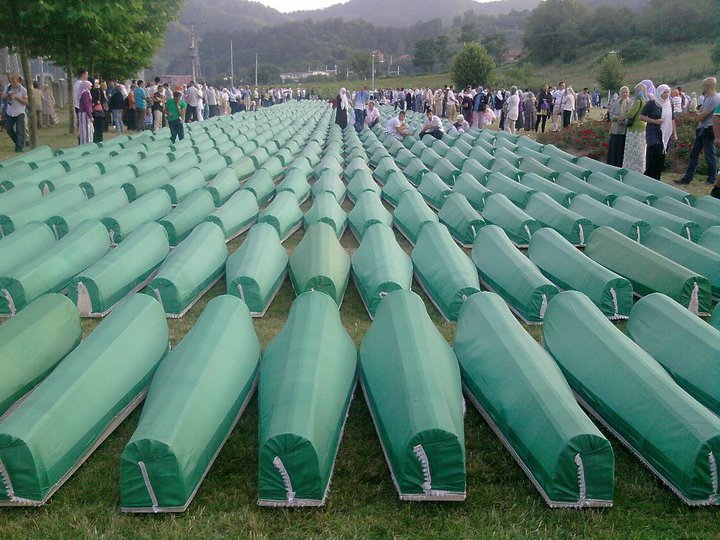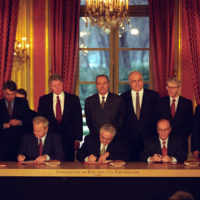![]() The end of the Cold War and the decline of Communism greatly altered the international political scene. The reunification of Germany, the collapse of the Soviet Union, and the departure of Czechoslovakia from Communist influence were among some of the changes.[1]
The end of the Cold War and the decline of Communism greatly altered the international political scene. The reunification of Germany, the collapse of the Soviet Union, and the departure of Czechoslovakia from Communist influence were among some of the changes.[1]
The Socialist Federal Republic of Yugoslavia led by Josip Broz Tito was one of the most liberal communist regimes. Tito kept control over diverse ethnic, religious, and nationalist groups under the umbrella of a unified ‘greater Yugoslavia.’[2] In the political vacuum after Tito’s death, politicians began exploiting nationalist rhetoric, pitting the Serbs, Croats, and Bosniaks (Muslims) against each other. The multi-ethnic republic of Bosnia quickly became the site of deadly warfare and ‘ethnic cleansing.’ The genocidal war claimed the lives of an estimated 200,000 people.[3]
 Bosnia, and the other five nations that made up the former republic of Yugoslavia, is located in southeastern Europe (also known as the Balkans) between Italy and Romania. The population is approximately 3.5 million people, with 48 percent of them Bosniaks, 37 percent Serbs, and 14 percent Croats. Bosnia is slightly smaller than West Virginia but with more than double the population.[4]
Bosnia, and the other five nations that made up the former republic of Yugoslavia, is located in southeastern Europe (also known as the Balkans) between Italy and Romania. The population is approximately 3.5 million people, with 48 percent of them Bosniaks, 37 percent Serbs, and 14 percent Croats. Bosnia is slightly smaller than West Virginia but with more than double the population.[4]
![]() In 1980, Tito died. He had held the economy together across the various republics, and in the absence of that strong leadership and control, the economies started to collapse. Leaders like Slobodan Milošević of Serbia and Franjo Tuđman of Croatia began to rise to power based on campaigns of propaganda and ethno-nationalism. From 1991-1992, Slovenia, Croatia, Bosnia, and Macedonia declared independence from Yugoslavia. These declarations of independence led to war breaking out in the former Yugoslavia. In 1992, the Siege of Sarajevo began. The war endured from 1992 to 1995.[5]
In 1980, Tito died. He had held the economy together across the various republics, and in the absence of that strong leadership and control, the economies started to collapse. Leaders like Slobodan Milošević of Serbia and Franjo Tuđman of Croatia began to rise to power based on campaigns of propaganda and ethno-nationalism. From 1991-1992, Slovenia, Croatia, Bosnia, and Macedonia declared independence from Yugoslavia. These declarations of independence led to war breaking out in the former Yugoslavia. In 1992, the Siege of Sarajevo began. The war endured from 1992 to 1995.[5]

A tower burns in downtown Sarajevo after heavy shelling, June 1992. Image by Mikhail Evstafiev | Attribution-ShareAlike 2.5 Generic (CC BY-SA 2.5) | License
Siege of Sarajevo
Bosniaks and Croats voted for independence from Yugoslavia in a referendum on March 1, 1992. The European Community recognized an independent Bosnia on April 6, 1992.[6] That day, Serb militants opened fire on thousands of peaceful demonstrators in Sarajevo, killing at least five and wounding 30. One day later, Serb leader Slobodan Milošević blocked all roads leading to Sarajevo and shut down the airport. Around 400,000 civilians were trapped and cut off from food, medicine, water, and electricity for the duration of the 1,425-day siege.[7] This was the longest siege of a capital city in modern history and it produced the worst atrocities in Europe since World II.[8]
Horrific violence and human rights abuses took place during the siege. At a soccer game in 1993 at least 15 people were killed and 80 were wounded by a mortar attack. Red Cross trucks were raided and destroyed and maternity wards were hit, killing mothers and newborns. Many more were killed while in line for water.[9]

Sarajevo residents collecting firewood, winter of 1992–1993. Image by Christian Maréchal| Attribution 3.0 Unported (CC BY 3.0) | License
Food scarcity was a major issue for those who survived death by sniper fire and mortar attacks. An average Sarajevan lost 30 pounds during the siege. According to UN officials, in 1994 over 7,000 flights brought nearly 82,000 tons of aid into Sarajevo via humanitarian airlift. However, this effort was often suspended due to airport closings caused by shelling and sniper attacks in the area.[10]
On February 29, 1996, the Bosnian government declared that the siege of Sarajevo was finally over. By that time, Sarajevo’s population had decreased by an estimated 200,000 people. That number includes those who escaped via an 800-meter tunnel that opened during the summer of 1993, the only direct link that Sarajevo had with the outside world. The tunnel began at the edge of the besieged city and ran under the airport to Bosniak held territory on the other side; it was used to transport food, medicine, weapons, and wounded people.[11]
Foča Rape Camps
Bosnian Serbs took control of the city of Foča in 1992 and began expelling Bosniaks. About 2,700 people went missing or were killed in Foča from 1992 to 1994. Men were sent to concentration camps and women and girls were taken to locations commonly described as ‘rape camps.’ Hundreds of Bosniak women and girls faced repeated sexual violence by Serb paramilitary forces in an estimated 20,000 rapes between 1992 and 1995 in Bosnia. The campaign against non-Serb civilians in the region also included ethnic cleansing, mass murder, and the destruction of Bosnian property and cultural sites, including the demolition of 13 mosques.[12]

Ongoing burials of identified Bosniak victims. Image by Juniki San| Attribution-ShareAlike 3.0 Unported (CC BY-SA 3.0) | License
Srebrenica Genocide
One of the most notorious massacres occurred near Srebrenica, a Bosniak-dominated town that had been officially declared a” Safe Area” by the UN. In July of 1995, Serb General Ratko Mladic and his troops entered the “Safe Area” where they overwhelmed UN forces; separated the women and children from the men; and murdered over 8,000 Bosniaks. It was the single largest massacre in Europe since World War II.[13]
Lašva Valley Case
The Lašva Valley case refers to war crimes committed by Bosnian Croats against Bosniaks in the Lašva River Valley region of central Bosnia. In 1992, Croats began destroying mosques and Bosniak homes, murdering civilians, and pillaging villages. In 1993, Croats targeted civilians by shelling major shopping centers and using Bosniaks as human shields in battle.[14] Nearly 2,000 community members disappeared or were killed at this time.[15]
The death of long-time communist leader Josip Broz Tito left a power vacuum and politicians Slobodan Milošević of Serbia and Franjo Tuđman of Croatia competed for control. Slobodan Milošević rose to power in 1987 and began a propaganda campaign exploiting nationalist rhetoric that incited hatred and violence and pitted Serbs, Croats, and Bosniaks against each other.[16]
Hundreds of concentration camps were established, mass killings were carried out, and Muslim mosques and historic sites were destroyed. People were pressed tightly into barracks and deprived of basic necessities. Despite media coverage, the global community failed to take significant action. Nearly 14,000 Muslim men were incarcerated in the camps and more than 10,000 of them perished.[17]
U.S. officials became aware of the concentration camps as early as May 1992. One of the worst was Omarska, where thousands of Muslim and Croat civilian men were held in metal cages and killed in groups of ten to fifteen every few days. Serbs denied access to those who wanted to investigate the camps, including relief officials and journalists. Serbs tried to cover up mass graves by moving bodies to mining sites where they were mangled by mining equipment or drenched in chemicals before being thrown into mine pits.
Violence was committed on all sides. Bosniaks and Croats also operated some camps where Serbs were detained.
Eventually, the United Nations deployed troops to protect the distribution of food and medicine to dispossessed Muslims, but their mandate as Peacekeepers didn’t allow any military interference. Throughout 1993, the Serbs were confident that the UN, the US, and the European Community (EC) would not take military action.
On February 6, 1994, a plea was made to President Bill Clinton for military intervention after an attack on a marketplace in Sarajevo killed 68 people and wounded over 200. Clinton issued an ultimatum through NATO, demanding that Serbs withdraw their artillery from Sarajevo. The Serbs complied, and a cease-fire was declared. Unfortunately, the Serbs continued to attack safe havens and UN peacekeepers. NATO responded by launching limited air strikes against Serbs’ ground positions, but that didn’t prevent the massacre in Srebrenica.[18]
![]()
Peace Talks
The genocide lasted from Bosnia’ secession in 1992 until the 1995 Dayton Peace Agreement.
In October 1992, Lord David Owen of the European Union and former U.S. Secretary of State Cyrus Vance proposed a draft constitution organizing Bosnia into a decentralized federation according to the “Vance-Owen” plan. Bosnian Serbs rejected this plan.
In 1994, the US decided to take on a more active role, seeking to back diplomacy with the threat of NATO air power in protecting” Safe Areas” and UN peacekeepers. That year, the U.S. special envoy helped reach a cease-fire between Bosnian Croats and Muslims. Shortly after, a five-nation Contact Group (United States, Russia, Britain, France, and Germany) drafted the 51/49 territorial compromise that all sides eventually accepted. The Dayton Peace Agreement allotted 51% of the country to the Croat-Muslim Federation and 49% to the Serb Republic. The main participants from the region were Serbian President Slobodan Milošević, Croatian President Franjo Tuđman, and Bosnian President Alija Izetbegović, with Bosnian Foreign Minister Muhamed “Mo” Sacirbey. After its initiation in Dayton, Ohio, the full agreement was signed in Paris, France on December 14, 1995.[19]
Part of the agreement mandated international organizations to monitor, oversee, and implement crucial parts of the plan. One of the major criticisms of the agreement is that the legal structure does not follow some of the basic principles of international law, leaving the Bosnian political situation highly unstable.[20]
In 1996, NATO’s Stabilization Force in Bosnia and Herzegovina sent 20,000 U.S. troops to prevent new hostilities. More than 60,000 NATO-led troops from over 40 countries were deployed. U.S. troops began pulling out of Bosnia in 2004. Per the Dayton Agreements, in 2004 the U.S. troops in Bosnia were replaced with 600 E.U. troops (EUFOR) in an effort dubbed “Operation Althea.” As of March of 2019, these 600 troops remain in Bosnia with the primary responsibility to maintain peace and security by supporting the authorities as needed.[21]
Justice Process
On May 25, 1993, while the conflict was still ongoing, the UN established the International Criminal Tribunal for the Former Yugoslavia (ICTY) in The Hague, Netherlands, to prosecute the perpetrators of the atrocities. It was the first international tribunal since the International Military Tribunal in Nuremberg after World War II and the first to prosecute the crime of genocide. In addition, it was the first time a tribunal had begun operations while a conflict was occurring, with a goal of providing some measure of deterrence against violence. 161 people, including Serbs, Bosniaks, and Croats, were indicted, and 90 people were convicted and sentenced. Notable cases included those of Radovan Karadžić, Slobodan Milošević, and Ratko Mladić.[22]
Serbian leader Radovan Karadžić was charged with genocide, crimes against humanity, and grave breaches of the Geneva Conventions for his role in the siege of Sarajevo and the Srebrenica massacre of 8,000 men and boys. He was arrested in Belgrade after being on the run for 13 years and was sentenced to 40 years in prison in March of 2016.[23] The United Nations Mechanism for the International Criminal Tribunal heard Karadžić’s appeal in March of 2019 and not only confirmed his 2016 conviction but extended his sentence to life in prison.[24]
Slobodan Milošević was indicted in May 1999 but was found dead of a heart attack in his cell in The Hague on March 11, 2006. His trial for genocide, war crimes, and crimes against humanity therefore ended without a verdict.[25]
Ratko Mladić, commander of the Bosnian Serb Army, was indicted for genocide, extermination, murder, deportation, inhumane acts, and other crimes against Bosnian civilians, most notably for his role in the siege of Sarajevo and commanding the Srebrenica massacre. Mladić was a fugitive of the ICTY until his arrest on May 26, 2011. On November 22, 2017, he was found guilty of genocide, crimes against humanity, and violating the laws or customs of war. He was sentenced to life imprisonment.[26]
The ICTY was formally concluded on December 17, 2017; however the UN International Residual Mechanism for Criminal Tribunals (IRMCT) continues to maintain appeals and monitor evidence collection.[27] War crimes prosecutions continue in the Bosnian national court system, where by the end of 2022 more than 200 cases remain pending. Justice is delayed for various reasons, as the caseload tests the limits of the court’s capacity, with external agencies estimating at least another six years before these trials are completed.[28]
Currently an uneasy peace holds in Bosnia. However, as specified in the Dayton Accords, Bosnia is one state but is divided from within. Specifically, the state is made up of three largely distinct communities–Bosniaks (Bosnian Muslims), Bosnian Croats, and Bosnian Serbs. Each of the three ethnic groups has its own president and prime minister. Every eight months the presidency is rotated among the three. Relations between Bosnia and Herzegovina (encompassing both Bosniaks and Bosnian Croats) and Republika Srpska (the region largely occupied by Bosnian Serbs) are still extremely fragile and cooperation is minimal at best.[29]
In October of 2019, President Milorad Dodik (representing Republika Srpska) was elected to serve his term as Bosnian President. However, Dodik has made it clear that he wants Republika Srpska to secede from Bosnia.[30] He has even gone so far as to directly deny the genocide, calling it a “fabricated myth.” Tensions are rising, and the international community is beginning to recognize the threat that Dodik poses for an increase in enmity.[31] As of February 2020, the Institute for Research of Genocide Canada sent a letter to Prime Minister Trudeau warning that Dodik is generating the destruction of Bosnia and Herzegovina and that sanctions against him must be implemented.[32] The US and the UK have both imposed sanctions against Dodik for his actions which threaten to destabilize the region in violation of the Dayton Accords.[33] Although Dodik no longer serves as Bosnia’s president, he remains in power as president of Republic Srpska. The threat posed by his dangerous rhetoric persists.
Looking forward, some interstate cooperation and progress have been made within the region. Bosnia, Serbia, and Croatia signed an agreement in 2019 to increase cooperation between the states in looking for the 12,000 remaining missing persons from the Yugoslav wars.[34] Within Bosnia however, an increase in genocide denial is building tension within the state. The consequences of the genocide denial and potential sanctions against the president remain to be seen.
Updated: Lindsay Hagen, August 2023
References:
[1] https://www.history.com/topics/cold-war/cold-war-history
[2] https://www.britannica.com/place/Yugoslavia-former-federated-nation-1929-2003
[4] http://worldpopulationreview.com/countries/bosnia-and-herzegovina-population/
[5] https://www.history.com/topics/1990s/bosnian-genocide
[7] Laurie R. Blank, Gregory P. Noone, “International Law and Armed Conflict: Fundamental Principles and Contemporary Challenges in the Law of War”
[8] https://www.npr.org/2012/04/05/150009152/two-decades-after-siege-sarajevo-still-a-city-divided
[9] Blank and Noone, op. cit.
[10] Blank and Noone, op. cit.
[11] http://news.bbc.co.uk/onthisday/hi/dates/stories/february/29/newsid_4667000/4667292.stm
[12] http://www.haguejusticeportal.net/index.php?id=8898
[13] https://www.britannica.com/event/Srebrenica-massacre/Aftermath
[14] https://www.icty.org/en/press/nine-more-persons-indicted-attacks-muslims-lasva-river-valley
[15] “IDC: Victim statistics in Novi Travnik, Vitez, Kiseljak and Busovaca”
[18] https://www.brookings.edu/articles/decision-to-intervene-how-the-war-in-bosnia-ended/
[19] Ibid.
[20] https://www.nato.int/cps/en/natolive/topics_52122.htm
[21] https://shape.nato.int/page39511625.aspx
[22] https://www.icty.org/en/cases/key-figures-cases
[23] Ibid.
[24] https://news.un.org/en/story/2019/03/1035051
[25] ICTY, op. cit.
[26] ICTY, op. cit.
[27] https://www.irmct.org/en/about
[28] https://www.justiceinfo.net/en/108796-time-running-out-war-crimes-prosecution-bosnia.html
[27] https://balkaninsight.com/2019/11/28/bosnian-prosecutors-struggle-to-tackle-backlog-of-war-cases/
[29] https://www.theatlantic.com/international/archive/2019/01/serb-president-dodik-bosnia/579199/
[30] Ibid.
[31] https://apnews.com/ba3e3d6495c545bab2592b8e197be030
[33] https://www.state.gov/imposing-sanctions-on-bosnia-and-herzegovina-officials-who-undermined-dayton-peace-accord/
[34] https://balkaninsight.com/2019/07/30/bosnia-croatia-serbia-sign-missing-persons-search-agreements/








